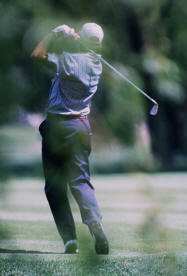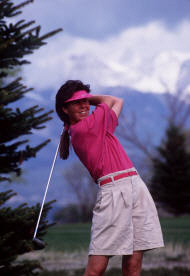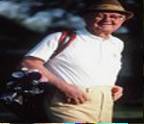

Welcome to the Jack-Long series of articles on golf
In this article Jack discusses the importance of body motion
Jack Long is a golf-theorist and founder of The Paranormal Golf Institute. He is working on a series of articles based in part upon: Cold War research documents in the field of paranormally controlled trajectories (PCT), documents recently discovered in the archives of the PCT Institute in Niblickvostock in the former Soviet Union; and ·His own, and other recent translations of the Golfnostic Gospels unearthed last year in caves near the northern Egyptian city of El Sandtrapya. The Golfnostic Gospels are hitherto unknown secret writings which describe the Second Century doctrinal disputes between Caddyus The Upright Prophet and Paul The Great Associationist.
Jack Long . . . Facts,.... Fiction,..... Hope
MID-BODY MOTION IN THE EXECUTION OF THE PUTT: A PUTTING TECHNIQUE THAT MAY BENEFIT SOME GOLFERS In the Golfnostic Gospels, Caddyus taught us about the ancient shepherd-activity known as Feriosaxum (literally, “to hit the rock”), what we now call golf. When asked by Beginnerus “What is the path to success at Feriosaxum?” Caddyus - relying on earlier teachings - told him that “Success depends upon rest and motion.” Caddyus was referring to that very brief period of calm or “rest” (necessary for bringing forth authentic inner confidence) which is followed by the seamless confluence of the “two motions” discussed by Plato.
Caddyus’ great insight about “rest and motion” formed the basis for his teaching that the “energy” (E) needed for powerful drives is a function of both player “motion” (M) and authentic inner “confidence”(E = MC). In the first article, we discussed Caddyus’ teaching about intestimus ludus, the so-called “inner game” of golf. In this article, we will discuss the “two motions” as they relate to putting. Caddyus taught that the motion of the staff was transmitted to the round rock, and that the energy of the transmitted motion depended upon its “confluence” with the shepherd’s self-generated motion. That’s what Caddyus’ two motions are all about. It’s that simple. Modern-day “experts” will use thousands of words to try to express this basic golf truth first set forth by Caddyus. At the outset, it must be acknowledged that there is a raging dispute in the Golfnostic Gospels Community as to whether Caddyus’ teachings about “motion” can be applied to both drives and putts. When Caddyus set forth his teachings about “rest and motion”, the shepherds thought only of using their staffs to whack their round rocks as far as possible toward a distant target. Nobody thought about tapping a round rock for a short distance; in fact, such an idea would have seemed not only silly, but also threatening to the masculinity of most shepherds. As an anthropological aside, this may help to explain why women are oftentimes better putters than men. Much has been written about body motion (i.e., self-generated motion) during the execution of the drive and fairway shots; except for the head, most of the body is in motion (as was recommended by Caddyus to the shepherds of antiquity). However, we have been instructed that body motion during the execution of the putt must be limited to movement of the arms and shoulders (with no mid-body motion). Even though the testing of my proposition is in the early stages, I believe that “self-generated motion” was so central to Caddyus’ teachings about the synchronization of “golf” to the eternal motion (and mystery) of the universe, that some players should consider the use of limited body motion during the putt. If I am correct, it will be effective for some players to remember the following, as they are about to putt: (a) Rest: Be calm momentarily in order to bring forth the authentic “inner putt”; and (b) Motion: The leading hip should be pointed to a point just before the mid-point of the trajectory of the putt, and as the stroke is taken, the player should rotate his/her hips slightly to follow the head of the putter to the end of the backstroke and then rotate them in the opposite direction to follow the head of the putter to a point just past the former resting point of the ball. It might be helpful for some players to have the words “Rest” and “Motion” inscribed on their golf balls in order to facilitate the necessary focus. It is my understanding that there is no prohibition in the Rules against such markings. See Rules 6-5 and 12-2 for more on this issue. The principles of Rest and Motion are much easier to remember than, for example, Dr. Bob Rotella’s “30 Rules For Putting”. Who can remember 30 rules and, if you want to try to remember some of them, which ones will you pick? I recommend following modern-day instructions regarding the location/movement of the player’s head during the course of the putt and regarding the grip on the putter. I am familiar with Freddy Freeman’s 18th Century observation that the best putters were Freemasons who used the secret handshake as their grip on the putter. I have not been able to find any references in the Golfnostic Gospels or any other authoritative sources to support the use of a putting grip which simulates the Freemason handshake. While the use of limited motion during the putt may not work for all players, I believe that it is close to the advice that Caddyus would have given to shepherds if they had been interested in “putting” in the 2nd Century. Furthermore, the orientation of the leading hip to a point just before the mid-point of the trajectory is consistent with the findings of two studies done in the early 1950s by the PCT Institute in Niblickvostock. While the PCT research addressed the orientation of field artillery toward a point on the trajectory to the target in conditions of wind sheer, the principles should be applicable to the movement of a golf ball along a trajectory on uneven ground.
5-Mid-Body Motion.10-25-05-A. No part of this article may be used or reproduced in any manner whatsoever without written permission from Jack Long, PGI, 192 College Street, Burlington, VT 05401.
You can read the previous Jack-Long-articles here The first in the Jack Long series ©Just For Golf 2006 |














































